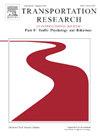使用类似大脑的认知计算模型来分析年轻司机在农村高速公路上期望速度和实际速度之间的差异
IF 3.5
2区 工程技术
Q1 PSYCHOLOGY, APPLIED
Transportation Research Part F-Traffic Psychology and Behaviour
Pub Date : 2025-02-01
DOI:10.1016/j.trf.2025.01.018
引用次数: 0
摘要
由于农村高速公路的技术标准较低,驾驶环境复杂,驾驶员特别是年轻驾驶员经常会遇到期望速度与实际速度存在较大差异(以下简称速差)的情况,导致交通事故频发。因此,本研究提出了一个类似大脑的认知计算模型,该模型包含三个子网络(即感知、认知和运动子网络),通过“感知-认知-行动”循环分析和预测年轻司机的速度差异。50名青少年在13.5公里的农村公路上进行了模拟驾驶实验。在驾驶过程中采集脑波信息(32通道脑电图)和实际速度,在观看驾驶录像时根据参与者自述数据获取期望速度。利用深度神经网络建立视觉道路环境模型(VREM),提取驾驶员感知的道路环境可量化参数,并将其作为感知子网络的输入。在本研究中,知觉、认知和运动子网分别由4台、3台和3台服务器组成。期望速度是认知子网络的输出,而实际速度是从运动子网络获得的。类脑认知计算模型采用考虑驾驶员异质性的线性混合效应模型进行计算。结果表明,使用类脑认知计算模型可以比单独使用VREM更准确地预测速度差异。这一发现有助于从创新的类似大脑的角度分析车速差异的原因,防止危险驾驶行为,从而促进先进驾驶辅助系统和类人自动驾驶汽车的发展。本文章由计算机程序翻译,如有差异,请以英文原文为准。
Using a brain-like cognitive computational model to analyze the difference between desired speed and actual speed on rural highways for young drivers
Due to the lower technical standards and complex driving environments on rural highways, drivers, especially young drivers, often encounter significant differences between their desired speed and actual speed (hereafter referred to as speed difference), resulting in frequent traffic accidents. Thus, this study proposes a brain-like cognitive computational model containing three subnetworks (i.e., perceptual, cognitive, and motor subnetworks) to analyze and predict young drivers’ speed difference through a “perception-cognition-action” loop. Simulated driving experiments were conducted on a 13.5-kilometer rural highway stretch with 50 young participants. Brainwave information (32-channel EEG) and actual speed were collected while driving, and the desired speed was obtained from participants’ self-reported data while they were watching their driving recording videos. A visual road environment model (VREM) was developed using deep neural networks to extract quantifiable parameters of the road environment perceived by drivers, which were then used as inputs for the perceptual subnetwork. In this study, the perceptual, cognitive, and motor subnetworks were composed of 4, 3, and 3 servers, respectively. Desired speed was the output of the cognitive subnetwork, while actual speed was obtained from the motor subnetwork. The brain-like cognitive computational model was calculated using the linear mixed-effects model that considers the driver heterogeneity. The results showed that using the brain-like cognitive computational model could predict the speed difference more accurately than using VREM alone. The findings could help to analyze speed difference causations and prevent risky driving behavior from an innovative brain-like perspective, thereby promoting the development of advanced driver assistance systems and human-like autonomous vehicles.
求助全文
通过发布文献求助,成功后即可免费获取论文全文。
去求助
来源期刊
CiteScore
7.60
自引率
14.60%
发文量
239
审稿时长
71 days
期刊介绍:
Transportation Research Part F: Traffic Psychology and Behaviour focuses on the behavioural and psychological aspects of traffic and transport. The aim of the journal is to enhance theory development, improve the quality of empirical studies and to stimulate the application of research findings in practice. TRF provides a focus and a means of communication for the considerable amount of research activities that are now being carried out in this field. The journal provides a forum for transportation researchers, psychologists, ergonomists, engineers and policy-makers with an interest in traffic and transport psychology.

 求助内容:
求助内容: 应助结果提醒方式:
应助结果提醒方式:


